一. Structure and Performance
1. Insulation Layer Design
●PV1-F: Single-layer irradiated cross-linked polyolefin insulation structure;
●H1Z2Z2-K: Double-layer insulation (insulation layer + sheath), better mechanical strength and temperature resistance.
Voltage and Temperature
2. Voltage Level:
●PV1-F: DC 1.0kV / AC 0.6/1kV;
●H1Z2Z2-K: DC 1.5kV / AC 1.0/1.0kV, higher transmission efficiency.
3. Temperature Resistance:
Both conductors have a maximum temperature resistance of 120°C, but the H1Z2Z2-K sheath is thicker, with stronger impact resistance and direct burial performance.
二. Application and Certification
1. Applicable Scenarios
PV1-F: DC connection between early photovoltaic modules and inverters;
H1Z2Z2-K: High-power systems (such as deserts and coastal areas), supporting multiple laying methods such as direct burial/overhead.
2. Standards and Certification
PV1-F: The discontinued German TUV standard (2PfG 1169/08.2007);
H1Z2Z2-K: Complies with the latest European standard EN 50618 and has passed TUV certification.
三. Protection and life span
1. Material properties
●Conductor: Both are tinned copper with consistent conductivity;
●Sheath:
●PV1-F: UV/oil resistant, but weak mechanical protection;
●H1Z2Z2-K: Halogen-free flame retardant (LSZH), low fire smoke toxicity, waterproof grade AD8.
2. Service life
●PV1-F: Fixed installation, life span of about 25 years;
●H1Z2Z2-K: Better anti-aging performance, suitable for complex needs of large power stations.
四. Summary
H1Z2Z2-K is superior to PV1-F in terms of double-layer insulation, high voltage support, and sheath protection, making it the first choice for modern high-power photovoltaic systems.



